Imagine that you came home on Friday evening and you are suffering from a terrible headache. What would you do? Will you suffer from the pain till Monday? This situation is quite possible in the world without telehealth apps. Nowadays, due to technological progress, you can make an appointment with a physician, receive a consultation, pay for such a service, and even get a receipt.
If you consider creating a telemedicine application, this article is what you need. Keep up to know more about telemedicine development, its trends, advantages, features, and price.
Table of Contents
- 1 What is Telemedicine?
- 2 Telehealth Market: Trends and Insights
- 3 Main Benefits of Telemedicine Apps
- 4 The Most Popular Telehealth Applications
- 5 Telemedicine App Features
- 6 How to Develop a Telemedicine App Step-by-Step
- 7 Choosing the Right Tech Stack
- 8 Monetization Strategies
- 9 Pitfalls of Telemedicine App Development
- 10 Cost of Telemedicine App
- 11 Our Expertise
What is Telemedicine?
Telemedicine is the remote delivery of healthcare services, including exams and consultations, over the telecommunications infrastructure. The very first time this term was used in 1900 in Australia. That time a doctor used a two-way radio powered by a bicycle treadle to transmit a medical advertisement. Since that time technology has gone ahead. Nowadays, nobody uses the radio. Instead of that, today, healthcare providers have telemedicine websites and mobile apps.
Initially, telemedicine was used to help patients that didn’t have access to traditional hospitals — mostly people living far from the cities or towns. After some time the technology that was used in case of necessity has become a convenience, allowing telemedicine to develop as an industry. According to Global Market Insights, in 2019, the telemedicine market was worth $45 billion and it was expected to grow almost 20% by 2026. The COVID-19 pandemic might have raised that number significantly.

Telehealth Market: Trends and Insights
The recent job postings show that there is a huge demand for telemedicine service specialists, especially psychiatrists, neurologists, dermatologists, allergists, pediatricians, immunologists, family doctors, etc.
Telemedicine implementation is so widespread that hospitals either actively invest in their adoption within their inpatient facilities or plan to do so in the next 18 months.
Particularly, the development of mobile telemedicine applications, which are setting trends in the creation of new ways of communication between doctor and patient, is showing steady growth with an expected growth rate of 35% over the next few years.
Sophisticated functionality neatly packaged into a simple mobile interface design to provide the best possible customer experience has allowed applications such as Doctor On Demand, LiveHealth, MDLive, Lemonaid, HealthTap to take the leadership position in telemedicine services.
Main Benefits of Telemedicine Apps
Now, when we are clear with the concept of telemedicine and its trends, let’s move on to the main advantages of the technology.
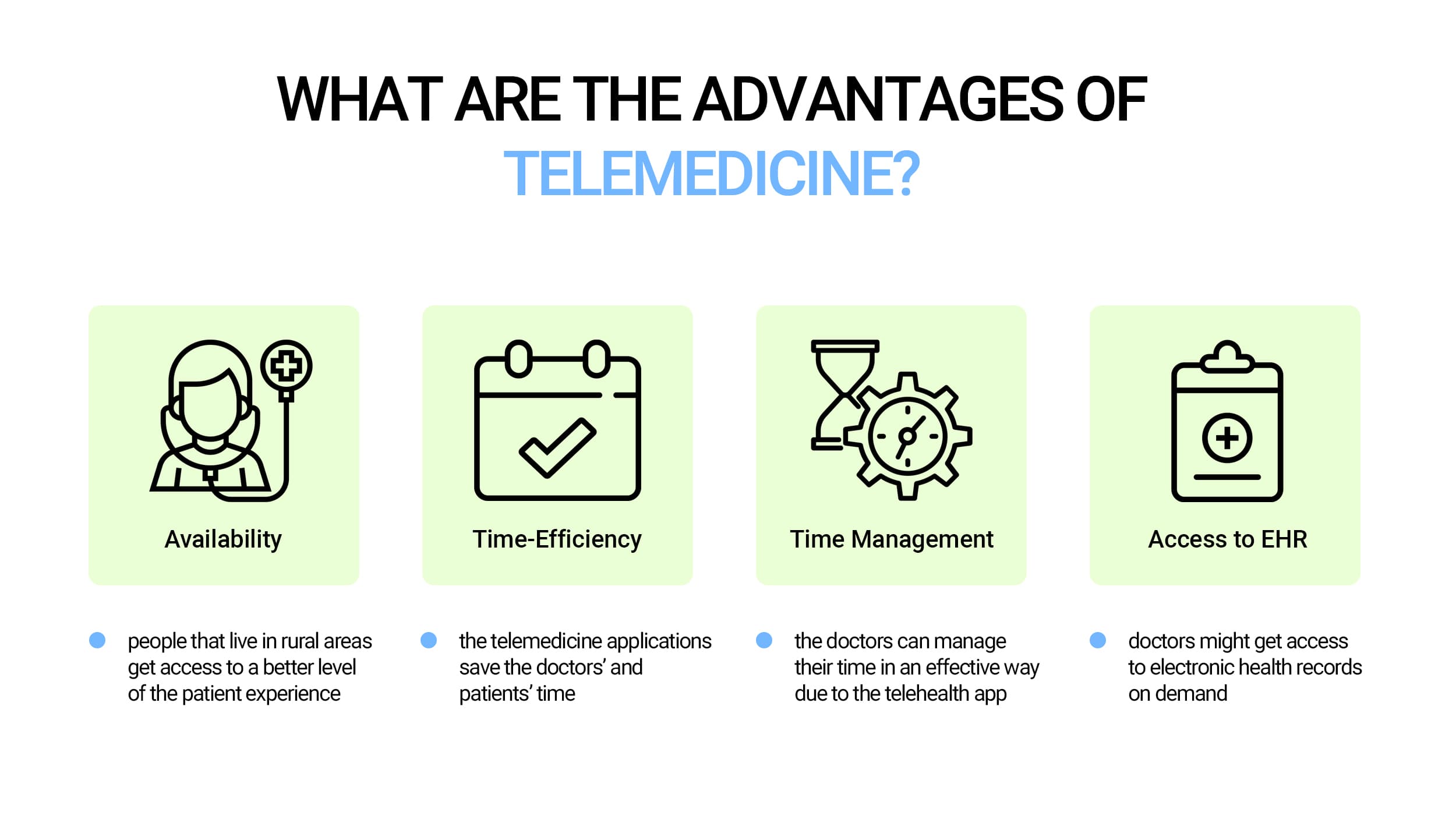
Due to telemedicine, people that live in rural areas get access to a better level of patient experience. The other groups of patients that benefit are elderly people and home-bound patients.
☑️Time-Efficient Treatment
The telemedicine applications save the doctors’ and patients’ time as nobody has to waste time getting to the clinic. One more important thing. In a typical hospital, some physicians are working while the other ones have day-offs. So, a complex screening may last several weeks and even more. Telemedicine decides this issue allowing patients to plan several appointments in a row.
☑️Effective Time Management for Doctors
The doctors can manage their time in an effective way due to such applications’ features like schedule and push notifications. Moreover, the clinic administration can track the physicians’ workload to maintain their work-life balance, while doctors can apply for sick days and shift changes via the application.
☑️Convenient Access to EHR
The software keeps electronic health records (EHRs). So, doctors might get access to them on demand. A single place for a patient’s clinical records saves the doctor’s time. Also, it gives patients the opportunity to keep updated about the corrections made in EHR.
The Most Popular Telehealth Applications
Some healthcare providers went online a long time ago. Here is a list of the most successful of them.
Teladoc
Teladoc is available only in the USA telemedicine application. It was founded in 2002 and currently, it’s the largest telehealth supplier. The app has a wide range of features. I.e., it gives customers an opportunity to add family members to their accounts and schedule appointments with a doctor for each of them. Patients have to describe the problem and attach a couple of photos if it’s needed to explain the issue. Also, customers can choose the nearest drugstore. When they get a prescription, it’ll be automatically sent to the chosen drugstore.
The app doesn’t have a fixed price plan. Prices vary depending on the patients’ problems.
Amwell
Amwell is another telemedicine app that has worked since 2006 in the USA and globally. The company offers a full set of technologies that might be provided online. Moreover, they have some extra features. I.e., the support of customers who are trying to quit smoking, and breastfeeding support.
Because of the variety of services it doesn’t have a fixed price as well.
Doxy.me
Doxy.me is a free app for patients that gives them the opportunity to search for a doctor everywhere. As for physicians, there are two different payment plans. Self-employed doctors have to pay $35/month or approx $350/year, while clinics have to pay $50/month for each provider or about $500/year plus $300 for the initial setup for clinics. The key feature of the app is a waiting room. So, physicians can see how many patients are waiting for a consultation right now.
As you can see, all the applications have their own business models and key advantages. Let’s go further and talk about what features are crucial and what you should strive for.
Telemedicine App Features
Any telehealth app presented with three components: doctor app, patient app, and admin panel. All three sides have different features according to their requirements. Below we list the most crucial features for each of the sides.
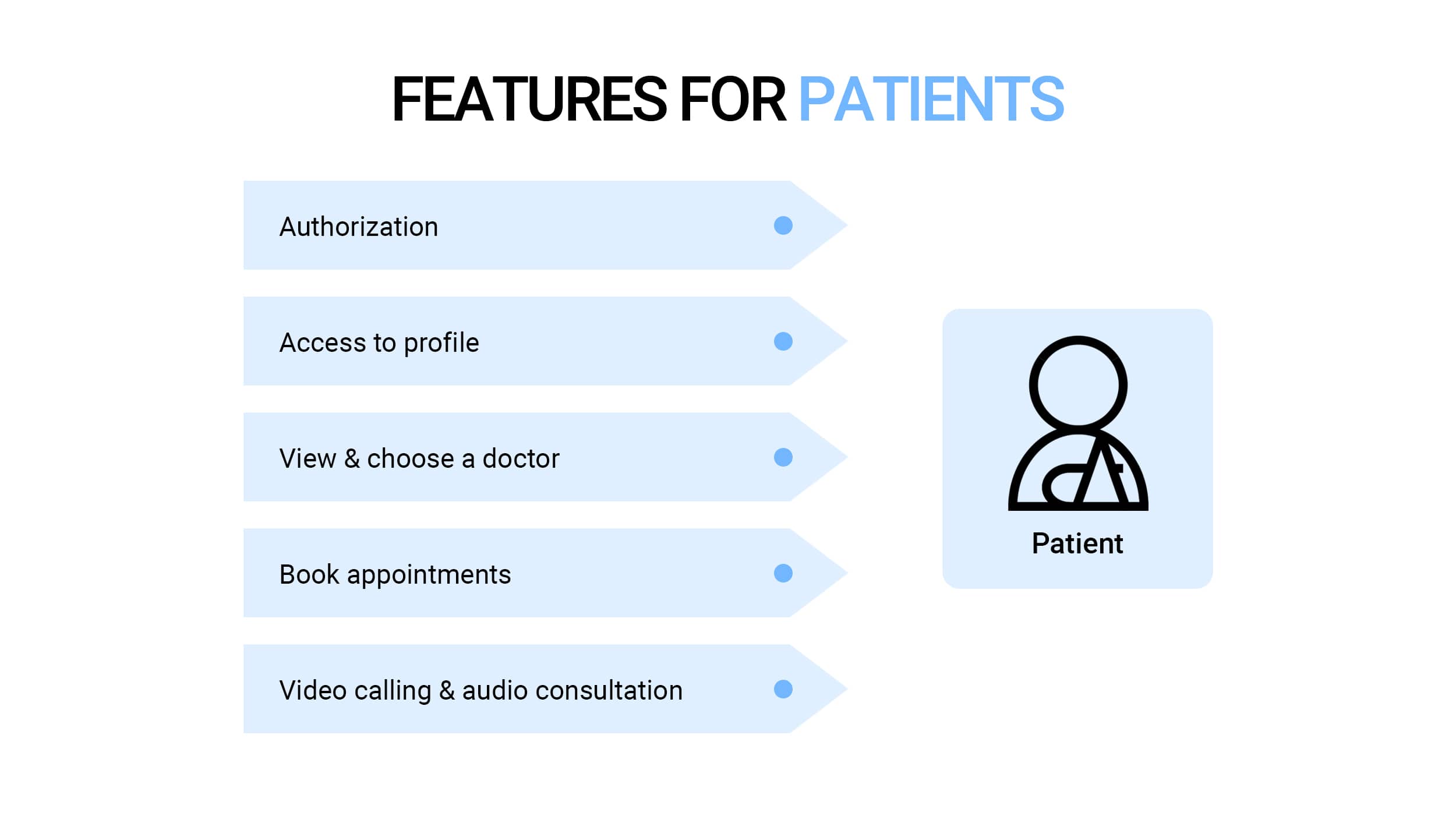
Features for the Patient’s Panel
- Sign up
- Access to profile
- View & choose a doctor
- Book appointments
- Video calling & audio consultation
- Choose the payment method
- Review & rate
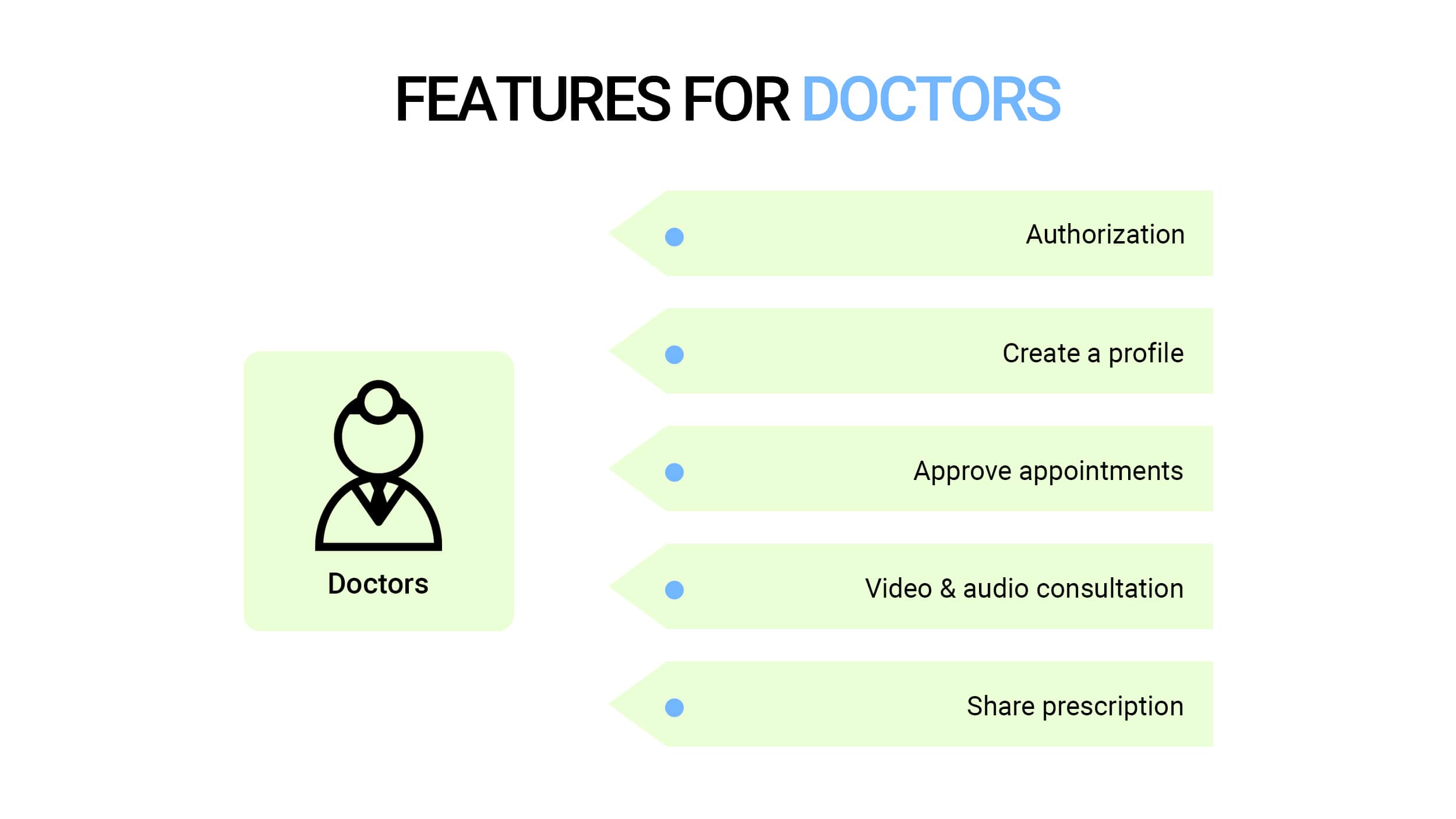
Features for the Doctor’s Panel
- Sign up
- Create a profile
- Approve appointments
- Video & audio chat
- Share prescription
- Manage payment
- View feedback
Features for Admin’s Panel
- Doctor management
- Patient management
- Appointment management for workflow flexibility, reducing doctors’ overload and increasing patients’ convenience
- Notification management for up-to-date communications
- Integration with EHR for seamless scheduling
How to Develop a Telemedicine App Step-by-Step
A telemedicine app development requires good timing, right planning, and execution. Listed below stages will explain how to create an application without missing anything.
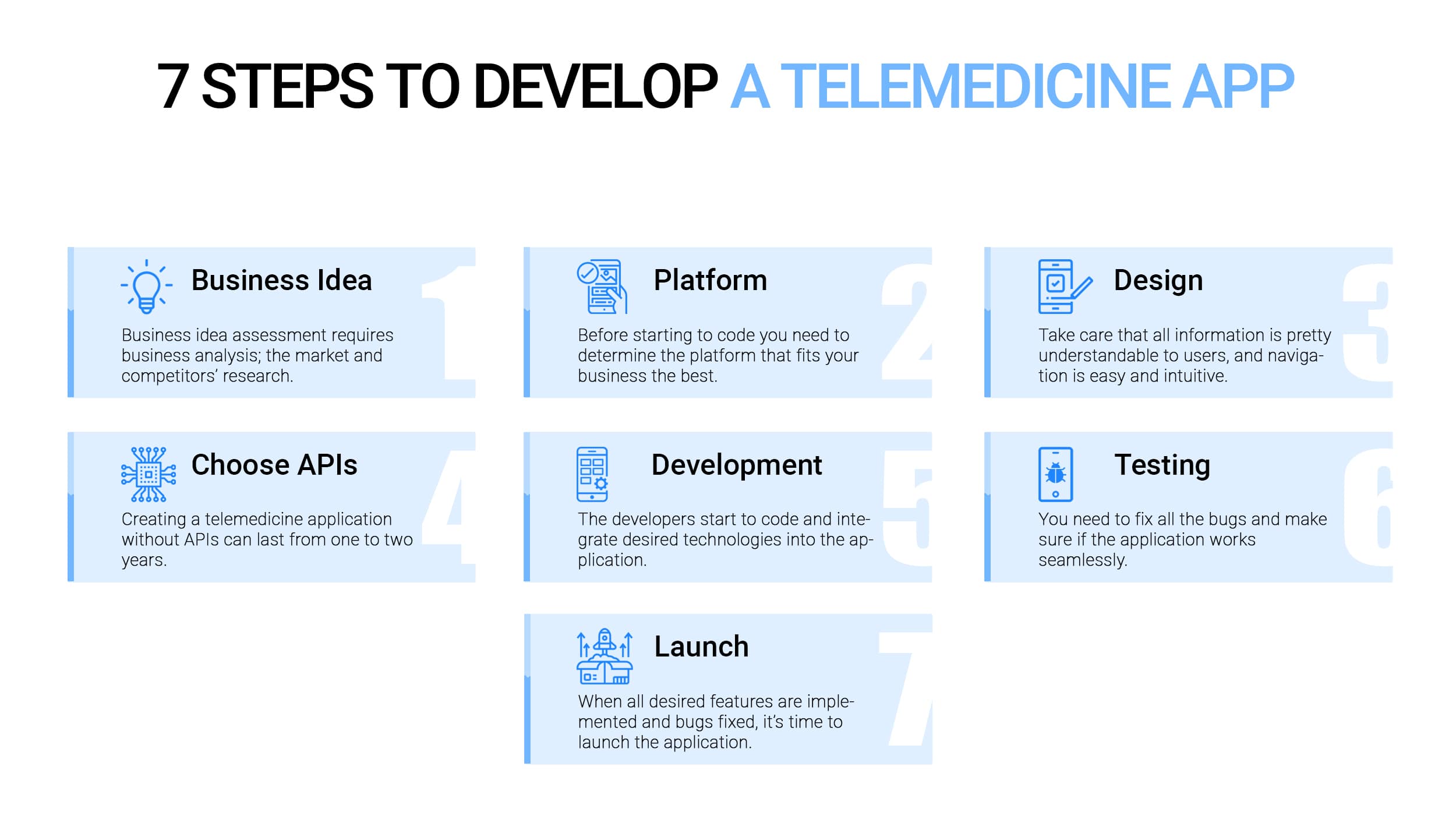
To build a useful application that will match future users’ expectations, the developers should understand all the project nuances. Because of it, you have to be ready to answer all the questions. Business idea assessment requires business analysis; the market and competitors’ research; a unique value proposition defining; creating a prototype; conducting testing, and getting feedback; marketing channels research.
2. Choose a Platform
Before starting to code you need to determine the platform that fits your business the best. It might be iOS and Android for mobile, web, and native for desktop. The desired features and target audience will direct your choice.
3. Create a Design
The design is the first thing people notice. That’s why the design phase is the most crucial in the whole mobile app development process. You need to strive to make the application as simple to use as possible. So, take care that all information is pretty understandable to users, and navigation is easy and intuitive. Different colors and button sizes have to be tested. User behavior is affected by colors and the position of elements on a screen.
4. Choose APIs for App Integration
Creating a telemedicine application without APIs can last from one to two years. But available components make the process faster and easier. There are plenty of them. We list the most widespread ones:
- VSee SDK is a telemedicine API with its own server-client. So, you don’t need to provision a server to set it up.
- Vidyo allows you to integrate real-time communication capabilities into your app on multiple platforms.
- WebRTC is a free and open-source platform that enables real-time communication in web and native apps.
- OpenTok allows you to integrate video, voice, text messaging, and screen sharing into your app on the web, iOS, Android, and Windows. It doesn’t support macOS.
5. MVP Development
At this stage, the magic starts to happen and your plans come into reality. The developers start to code and integrate desired technologies into the application.
6. Testing the Telemedicine Application
After the development has finished you need to fix all the bugs and make sure if the application works seamlessly.
7. Launch of the Application
When all desired features are implemented and bugs fixed, it’s time to launch the application. However, this is not the end of the development. And in some cases, it is just the beginning. The best approach to make your application a big success is following the Lean Startup Methodology. It aims at the approach of build, measure, and learn.
Choosing the Right Tech Stack
To build a telemedicine application you need to use the list of programming languages, frameworks, third-party tools, and cloud storage. Here is the main of them:
Chatbots & AI
Chatbots & AI are the most promising technologies in telemedicine. Obviously, doctors can’t be in touch 24/7. In this case, a simple chatbot can answer the client’s questions about the doctor’s schedule, competency, etc. Chatbots aren’t able to prescribe any medicines, but they can facilitate routine processes.
Internet of Things (IoT)
IoT helps doctors to monitor a patient’s condition and offer urgent medication or advice in case of an emergency. Also, all these tools like fitness trackers, stress meters, scales allow doctors to gather the person’s health statistics and correct treatment plans according to the data.
Cloud Storage
All collected information about the patients’ health should be stored in clouds and be accessible via the Internet. You can use AWS (Amazon Web Services), Microsoft, or IBM cloud storage services. They provide full data security.
Blockchain
All patients’ data have to be secure. It’s possible to achieve it due to Blockchain technologies. Blockchain provides highly secure data transfers and data storage.
Now, you are familiar with the technologies that make your application outstanding. So, it’s time to go further into the programming languages and frameworks.
Programming languages:
- Kotlin, Java (Android)
- Swift (iOS)
Back-end development:
- Programming language: Node.js
- Video conferencing: RTMP, Twilio, WebRTC
- Chat: Twilio, Socket.io
- Database: MySQL
- APIs and frameworks: Stripe, EC2, S3
Tools:
- Search & filters: Elastic search
- Mailing: Elastic Emails
- Geolocation: Google Maps Platform
- Notifications: Firebase Cloud Messaging
A tech stack may vary depending on your requirements. But the listed above technologies are the most common and usable.
Monetization Strategies
Any app won’t live long without funding. So, let’s take an in-depth look at the main revenue strategies for telemedicine applications.

The subscription model is the most common way to make money on the telemedicine application. In this case, the patient and the doctor both need to pay a certain amount of money for using software monthly or yearly.
✓Freemium
Freemium supposes that the company offers some services for free. Even so, the application has additional features that are available only for a premium subscription. This approach means that the premium version users subsidize the ones who use the application for free. Thus, the more users will be interested in using the app for free, the more of them will convert into premium subscribers.
✓Fees
The fee is the most widespread monetization strategy. It means that the application will charge a fee for all transactions made from the patient to the doctor.
✓A per-minute charge
This approach means that customers have to pay for every minute of a consultation with a doctor.
✓Franchising
If the local market is overcrowded, why not go to another market? You can offer the franchise to other health organizations.
It’s important to choose the monetization strategy in advance as the development processes depend a lot on your choice.
Pitfalls of Telemedicine App Development
The history of telemedicine applications dates back to the 1960s. So this means the advantages outweigh the minor disadvantages of app development. Nevertheless, there are some challenges that programmers can face.
Let’s figure out the main problems.
HIPAA Compliance
Before the mHealth app development, you should be aware of HIPAA. HIPAA is an abbreviation for the Health Insurance Portability and Accountability Act. To build a telemedicine application and to fail you have to know each of 155 pages of this act. The act was created to modernize the flow of healthcare information and protect personal data from fraud and theft. The major issue of this regulation is enormous fines for the application’s non-compliance with standards.
Security
Telemedicine applications store the patients’ private information. So, it makes people wonder if this data in a safe place and is there any access for strangers. To protect your customers you should implement multiple-factor authentication and data encryption. These measures will protect the application from data breaches.
Video Quality
According to statistics, poor audio (19%), poor video (13%), and audio interruption (9%) have a negative influence on the reliability of virtual healthcare visits. It may look like a minor problem. But it really matters when a person has to show his traumas to a doctor. In this case, the bad quality video may be a cause of wrong diagnosis and improper treatment. Device cameras play a significant role in video quality. But it may also be a result of poor code or bandwidth problems.
Limitations for Doctors
This point concerns telemedicine in general. Despite the fact that 74% of millennials prefer telehealth visits to in-person doctor exams, telemedicine can’t provide the same results as conventional. It’s impossible to make an ultrasound, X-Ray, or comprehensive examination remotely. Telemedicine is an excellent option for preventive and maintaining medicine but it can’t totally substitute habitual hospitals.
Cost of Telemedicine App
The final price of creating a telemedicine app mostly depends on your requirements and the desired list of features. They define the time taken for the app to develop.
Also, it depends on the country from where you are going to hire developers. Developers from the USA usually have high hourly rates unlike programmers based in Eastern Europe.
| Scope | Approx time, hours |
| 1. Project Start | |
| Initial backlog preparation | 7 |
| Project Schedule Preparation | 7 |
| Staging environment setup | 20 |
| 2. Development Section (Back-end) | |
| Login endpoint | 4 |
| Signup endpoint | 4 |
| Forgot password | 8 |
| Login/signup with Google/Facebook | 8 |
| Roles management | 23 |
| User management | 24 |
| Video | 16 |
| Images | 4 |
| Meetings | 24 |
| Notes | 16 |
| Statistics | 8 |
| Notifications | 16 |
| Company management | 24 |
| Payment API | 40 |
| 3. Development Section (Front-end) | |
| Login Page | 6 |
| Signup page | 6 |
| Forgot password page | 6 |
| Login/signup with Google/Facebook | 8 |
| List of professionals with filters and sorting | 6 |
| Doctor profile | 8 |
| My meetings page | 8 |
| My notes page | 6 |
| My note page | 6 |
| Account settings page | 10 |
| Integrate payment API | 16 |
| Multilanguage support | 12 |
| Push notifications | 8 |
| Meeting room | 40 |
| Make a note in the meeting | 8 |
| 4. Stabilization and Delivery | |
| Prepare deployment docs | 12 |
| Prepare description docs | 12 |
| Production deployment | 16 |
| 5. Project management | |
| Backlog elaboration and maintenance | 21 |
| Planning meetings, review meetings | 19 |
| Project Management and communication | 24 |
| Quality Assurance, hours: | 103 |
| Total Development, hours: | 413 |
| Estimated management project time, hours: | 98 |
For calculating the total cost there is a pretty simple formula: Time Taken for the App Development x Hourly Rate of the Developer.
Usually, the price varies from $59 000 to $149 000 depending on the project complexity. On the lower end, we talk about the minimum variable product (MVP). On the higher end, we suppose an advanced web platform.
How long does it take to build a website? [Estimation examples]
Our Expertise
Code&Care team has immense experience in telemedicine applications development. Though most of the clients we have are under NDA, there is one case we can show you.
eCare Nordic AB is a video calling healthcare application that provides customers easy access to booking and having a video or voice-only call with doctors. The key features include user-friendly, simple, and intuitive design with maximum protection for user data.
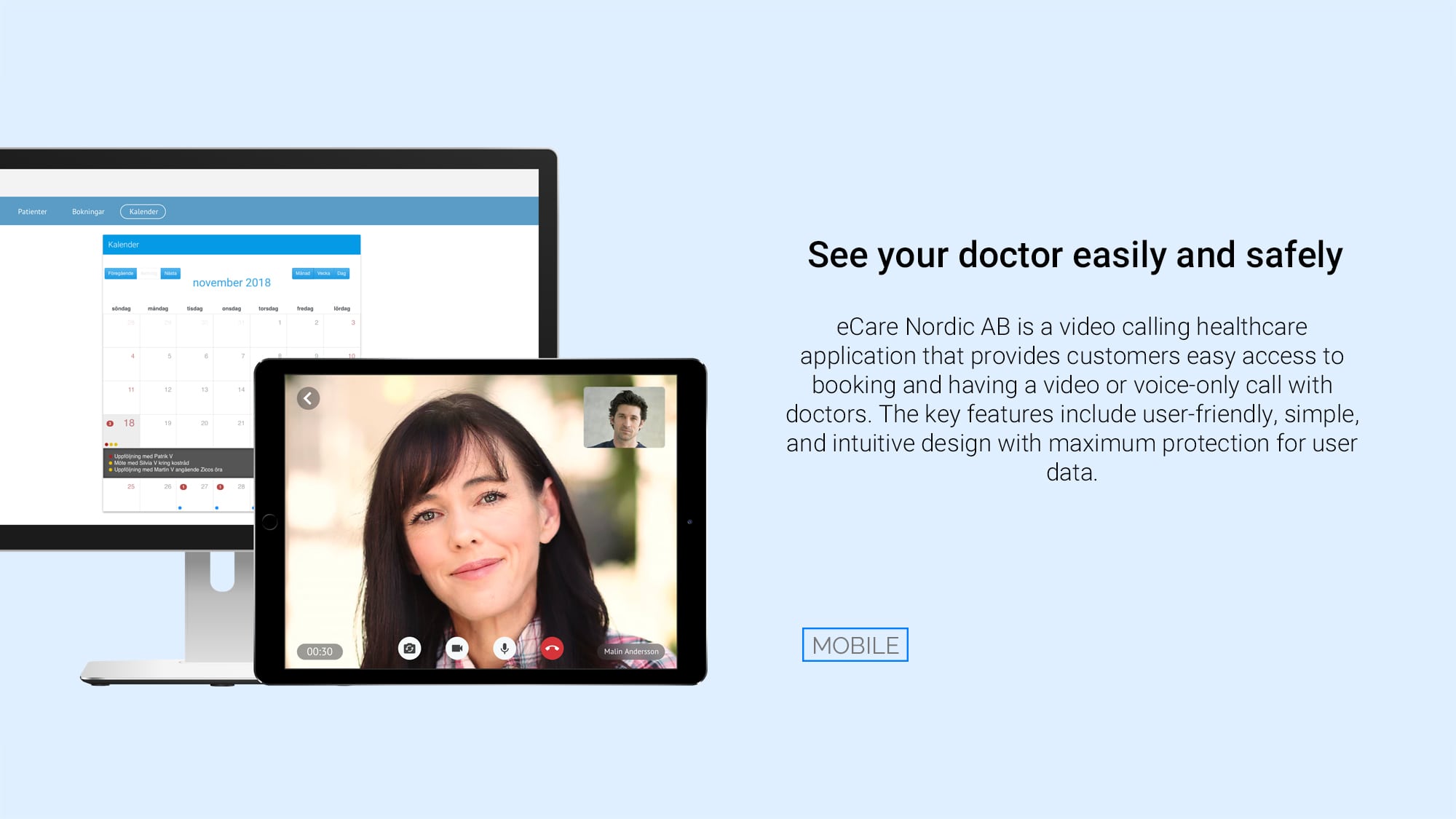

How to Build Your Own Auction Website Like eBay
How to Build a Marketplace Website That Users Will Love
How to Build a CRM Software: Types, Features, and Cost
How to define your web development team structure
















Popular
Latest